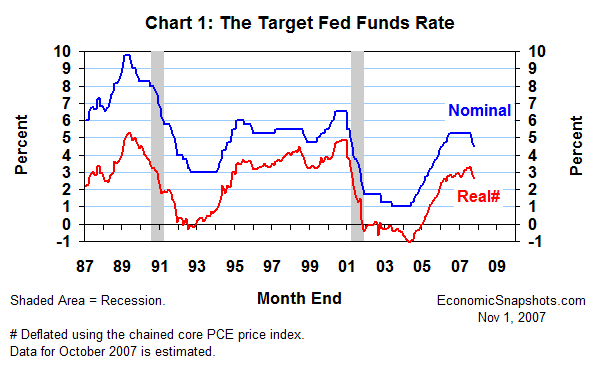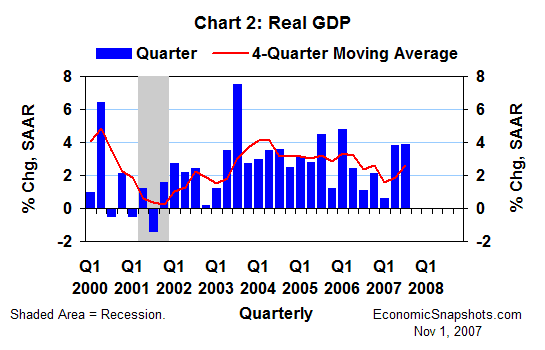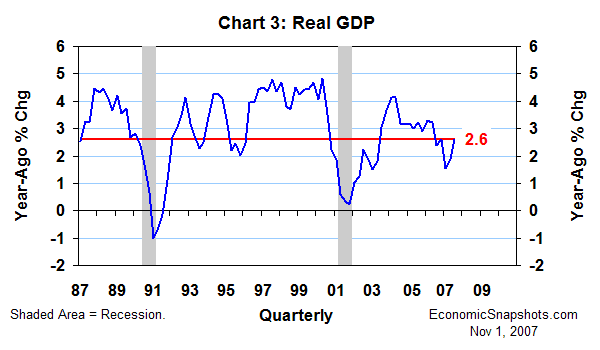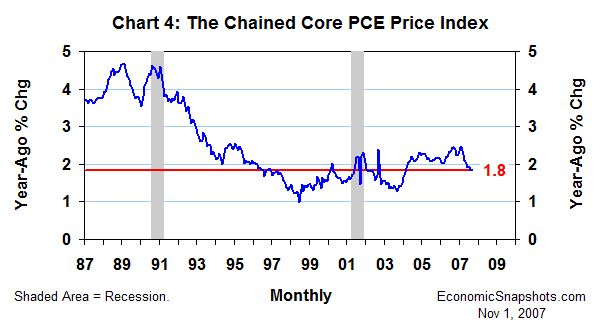
| Back to Index |
November 1, 2007 – The FOMC voted on Wednesday to lower its target Fed funds rate by 25 basis points to 4.5% (Chart 1). That was the second straight cut. At its last policy meeting, in September, the FOMC reduced its Fed funds target by 50 basis points.

Unlike September, the FOMC’s policy vote was not unanimous this time. Kansas City Fed President Hoenig wanted to leave the Fed funds target unchanged at 4.75%.
According to the FOMC’s post-meeting policy statement, “Economic growth was solid in the third quarter, and strains in financial markets have eased somewhat on balance.”
In September, the FOMC saw merely “moderate” economic growth, and worried that the turmoil in the credit markets might trigger a recession.
As in September, the FOMC described Wednesday’s easing action as a preemptive move, aimed at limiting any future real economic damage that might otherwise arise as a result of “disruptions” in the financial markets.
In other data released on Wednesday, real GDP rose at almost a 4% annual rate for the second straight quarter in Q3 (Chart 2). That’s probably too strong for the FOMC’s goal of “sustainable” (non-inflationary) economic growth.

But, with weaker increases in both of the prior two quarters, real GDP growth did average a “moderate” 2.6% annual rate for the four quarters through Q3 (Chart 3). That seems to be more or less in line with what the FOMC wants to see.

Looking ahead, the FOMC believes that “the pace of economic expansion will likely slow in the near term, partly reflecting the intensification of the housing correction.” In fact, without some slowing in Q4 and beyond, the four-quarter trend in real GDP growth would also start to exceed the FOMC’s tolerance limits.
On the inflation front, the FOMC continued to see some modest improvement in the core inflation indicators this year.
But the FOMC also noted that “recent increases in energy and commodity prices, among other factors, may put renewed upward pressure on inflation”. Thus, the FOMC will “continue to monitor inflation developments carefully”.
In data released today, the chained price index for personal consumption expenditures excluding food and energy (the FOMC’s preferred inflation gauge) rose at a fairly sedate 1.8% in the twelve months through September, the same as in August (Chart 4).

With Wednesday’s easing action in place, the FOMC said, the economy’s downside real growth and upside inflation risks are now currently in balance. That suggests, in turn, that the FOMC majority does not currently see any need for any further changes in U.S. monetary policy.
As noted in the FOMC’s September minutes, the FOMC refrained from any making any explicit comments about the economy’s balance of risks in its last policy statement, because conditions were too uncertain then.
As always, the FOMC “will continue to assess the effects of financial and other developments on economic prospects and will act as needed to foster price stability and sustainable economic growth.”
Suzanne Rizzo